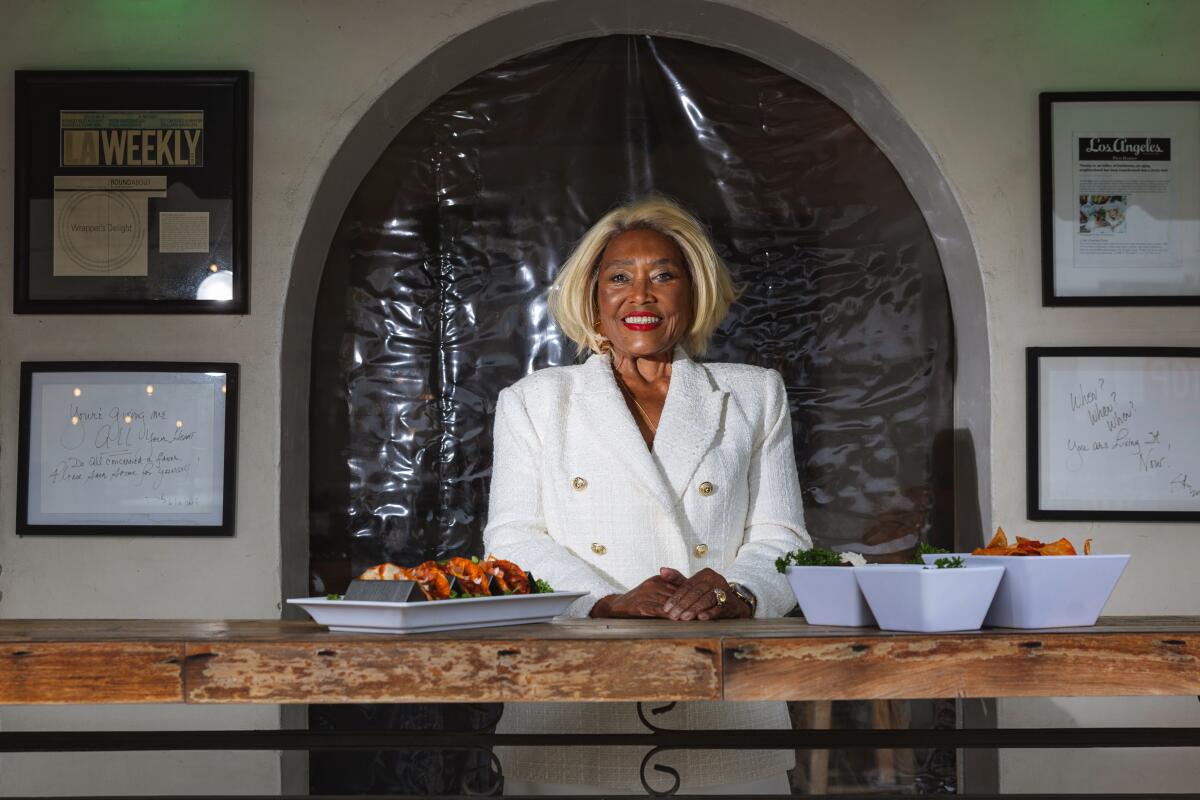California’s stunning snow drought turnaround, in three charts

- Share via
Good morning. It’s Friday, Feb. 23. Here’s what you need to know to start your day.
- Recent storms have helped the Sierra snowpack
- The Dodger Stadium gondola project is one step closer to being built. But the battle continues at a Chinatown housing project
- Customers wait hours for tacos from this Leimert Park window
- And here’s today’s e-newspaper
Sign up for Essential California
The most important California stories and recommendations in your inbox every morning.
You may occasionally receive promotional content from the Los Angeles Times.
California’s once-feared “snow drought” has faded
At the beginning of the year, the snowpack in the Sierra Nevada was 28% of normal. The mountain range, which provides roughly 30% of the state’s water supplies on average, was getting some rain. But warmer conditions meant it wasn’t turning to snow at higher elevations.
If California’s “snow drought” persisted further into winter, state water experts feared less water would melt off the mountains and flow into reservoirs just when it’s needed most.
But what a difference a rainy month makes. After getting through the bad kind of dry January, a series of storms in recent weeks have eased those concerns — though snowpack is still slightly below average.
These charts from Times assistant data and graphics editor Sean Greene show how much the recent rounds of atmospheric rivers have helped.
The snowpack measured Feb. 21 was at 86% of average for that date. The biggest benchmark is coming up on April 1, which marks the end of the wet season when snowpack typically hits its peak in the peaks. 🏔️
As Times reporter Ian James noted, “how close the state comes to an average snowpack will depend on conditions over the next five weeks.”
Although the snowpack is a bit below average, as of Feb. 21, California has received more rain than average this water year, which ends Sept. 31.
Part of that discrepancy stems from the warmer temperatures caused in part by this year’s El Niño pattern, but as Ian explained, that’s not the only factor:
“Rising temperatures driven by human-caused climate change have led to declines in the average snowpack in the western United States in recent decades. Research has shown that average snowlines have been creeping higher with warming temperatures as more precipitation falls as rain instead of snow.”
And SoCal has been exceptionally doused this year. UCLA climate scientist Alex Hall told Ian the region has received “roughly 125% of what we normally get in the whole water year. And the wet season isn’t over yet.”
A downside to so much rain in the L.A. Basin and other parts of the state is that most of that water ends up in the ocean instead of being captured and stored for local use.
Still, recent storms have put California’s reservoirs in a better position with the dry season approaching. Our major reservoirs are still at 118% of their average levels, thanks in large part to the previous banner water year.
Statewide, reservoirs are almost at 75% capacity. That means more water is available for cities and agriculture this year.
While our rainy season has been notably wet for a second year, how state and local water managers respond to the abundance will determine how well California weathers the next drought — which will come.
“We need to be accelerating and expanding conservation and efficiency policies,” hydroclimatologist Peter Gleick told me last year. “It’s precisely in the wet years, when we have a little breathing room, that we ought to be doing more to prepare for the dry years that we know are increasingly frequent.”
Today’s top stories

Rebecca Grossman trial
- Rebecca Grossman trial goes to jury with central question: Murderer or scapegoat?
- Two children are dead; Rebecca Grossman says she’s no murderer. Justice is now in the hands of the jury.
Crime and courts
- A judge blocks a California law targeting suppliers of “abnormally dangerous” firearms.
- A man was arrested in the brutal slaying of an L.A. model whose body was found in a refrigerator.
- He opened a fake Botox practice. Days out of prison, he tried it again, D.A. says.
- ‘Sloppy’ or ‘a scapegoat’? Two portraits of ‘Rust’ armorer emerge at trial.
Politics
- In the Bay Area, Biden vows to restore abortion access amid legal uncertainty about fertility treatments.
- Teachers union halts support for LAUSD candidate, citing offensive social media activity.
- A bill to make more rentals pet-friendly would put an end to “no dogs allowed,” a lawmaker says.
- Trump as the candidate of stability? That’s how many voters now see it.
More big stories
- Toys, turkeys and grants: How backers and critics of the Dodger Stadium gondola are wooing locals.
- The battle brewing over California workers’ unique right to sue their bosses.
- EPA orders action at Chiquita Canyon landfill, says leaks pose imminent endangerment to nearby communities.
- A total solar eclipse will be visible to millions of Americans in April. Here’s how to view it.
- Wendy Williams has been diagnosed with frontotemporal dementia and aphasia, her reps say.
- Trevor Bauer wants back in the majors: “I don’t believe that I was given a lifetime ban.”
- Volkswagen to recall 261,000 cars because of fire risk.
- Is your phone working? Americans report nationwide cellular outages.
- L.A. County accuses Grubhub of “bait-and-switch” with last-minute fees.
Get unlimited access to the Los Angeles Times. Subscribe here.
Commentary and opinions
- Harry Litman: Alabama’s highest court declared frozen embryos people. The U.S. Supreme Court is to blame.
- Commentary: Shane Gillis, who was fired by “SNL” over bigoted remarks, is hosting. What changed?
- Editorial: House Speaker Mike Johnson must stop dithering on Ukraine aid and hold a vote.
Today’s great reads
How we made tacos a Black thing in L.A. For more than three decades, Black chefs in Los Angeles have been making the taco their own, turning it into a staple of California soul cuisine.
Other great reads
- Customers wait hours for tacos from this Leimert Park window. They’re worth it.
- This bird whisperer is keeping the 4,000-year-old tradition of falconry alive in L.A.
- The antisemitic cartoon roiling Harvard? It’s not the first time it caused a firestorm.
- A scholar’s Native American heritage was questioned. Who gets to decide her identity?
- SAG honoree Barbra Streisand on acting, Oscar snubs and singing with Bob Dylan.
How can we make this newsletter more useful? Send comments to essentialcalifornia@latimes.com.
For your downtime

Going out
- 🏃🏽Anyone can run. These 18 L.A. run clubs bring the good vibes to help you keep going.
- 🌮 In L.A., tacos are soul food. Here are nine spots that prove it.
- 🎞️ Made by a solo Coen brother, “Drive-Away Dolls” — in wide release Friday — is trashy fun and exceedingly disposable.
Staying in
- 📺 HBO is renewing “True Detective” for a fifth season.
- 🧑🍳 Here’s a recipe for Pork And Shrimp Lumpia Shanghai with cracked pepper coconut vinegar sauce.
- ✏️ Get our free daily crossword puzzle, sudoku, word search and arcade games.
And finally ... a great photo
Show us your favorite place in California! We’re running low on submissions. Send us photos that scream California and we may feature them in an edition of Essential California.

Today’s great photo is from Times photographer Jay L. Clendenin at the home of actress Leslie-Anne Huff and Reggie Panaligan. Los Angeles architect Lisa Little designed a trapezoid-shaped, 380-square-foot ADU with an asymmetrical butterfly roof.
Have a great day, from the Essential California team
Ryan Fonseca, reporter
Kevinisha Walker, multiplatform editor
Stephanie Chavez, deputy metro editor
Check our top stories, topics and the latest articles on latimes.com.
Sign up for Essential California
The most important California stories and recommendations in your inbox every morning.
You may occasionally receive promotional content from the Los Angeles Times.





